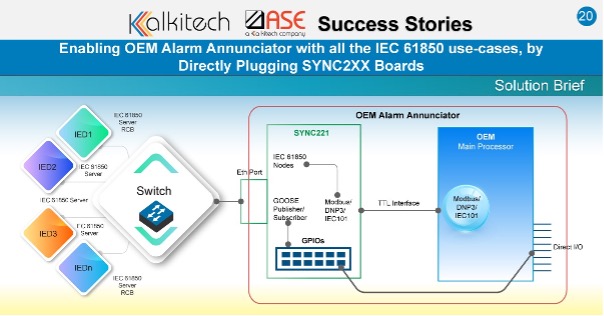Enabling OEM Alarm annunciator with all the IEC 61850 use-cases, by directly plugging SYNC200 embedded modules
Kalkitech December 25, 2023

Kalkitech December 25, 2023

Customer: Multiple Fault Alarm Annunciator Manufacturers across the globe
Application Area: Utilities
Business Case:
The Fault Alarm annunciators were having protocols like Modbus / IEC 101 / DNP3 for fetching data from other devices and sending the annunciation status to the SCADA system. These Alarm Annunciators wanted migration to IEC 61850 and wanted to use the complete feature sets of IEC 61850. Many alarm annunciators also had direct I/O interfaces and they wanted these data to be exchanged via GOOSE publisher/subscriber blocks. As these Alarm Annunciators were using native tools and their protocols for configuration, it was needed to use the same for any configuration, even after the migration. Also, there were very fast migration requirements as these OEMs were losing opportunities because of the IEC 61850 requirements and newly launched alarm annunciators complying with the same completely.
The Solution:
The SYNC200 Embedded protocol modules were plugged internally into the OEM device, interfaced with the TTL port to the device at one end, and directly exposing the SYNC200 Ethernet interface from the enclosure of the annunciator. The Ethernet interface had the option of IEC 61850 for collecting data from the IEDs or other devices and could also be used to exchange the data to SCADA via IEC 61850. The data exchange with the OEM device & SYNC200 was possible using the protocol supported by the device & could use the interfaces of TTL / I2C / SPI. For exchanging the fast messages via GOOSE, the I/Os associated with the alarm annunciators were directly connected to the GPIOs available in SYNC200 and Fast-Message-GOOSE-Bus functionality available in the unit was used for exchanging the data. Transparent / Pass-Through functionality within the SYNC 2XX for configuration scenarios using the existing tool and its native protocols were used for the requirements of configuring the alarm annunciators. For the latest requirements of IEEE1588 based time sync and PRP network redundancy requirements there was the flexibility of using SYNC261 with 2 * 10/100/1000-BASE-TX & 100-BASE-FX options.
Key Benefits:
By plugging the SYNC200 module internally into the alarm annunciators, the OEM was provided with the following key benefits.

July 25, 2025
The world energy scene is being revolutionized by the fast-paced increase of decentralized renewable energy sources like rooftop solar, wind microturbines, and energy storage in batteries. batteries. The driving force…
Know More
July 25, 2025
Smart metering has evolved significantly over the last two decades as it became a building block of modern energy management solutions. At the core of the evolution is the DLMS/COSEM…
Know More
July 25, 2025
As the energy sector undergoes rapid digital transformation, smart metering has emerged as a foundational technology in modern utility networks. By enabling real-time monitoring, automated billing, and remote disconnection, smart…
Know More